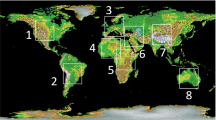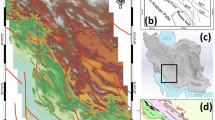Abstract
Digital elevation model data were used to partition a mountainous landscape (northwestern Montana, USA) into watershed/hillslope terrain units at several different spatial scales. Fractal analysis of the perimeter to area relationships of the resulting partition polygons identified statistical self-similarity across a range of spatial scales (approximately four orders of magnitude in partition area). The fractal dimension was higher for a relatively complex fluvially-dominated terrain than for a structurally simpler glacially-dominated terrain (1.23 vs. 1.02, respectively). The structural self-similarity exhibited by this landscape has direct implications in scaling up ecosystem process models for landscape to regional simulations.
Similar content being viewed by others
References
Band, L.E. 1986. Topographic partition of watersheds with digital elevation models. Water Resources research. 22: 15–24.
Band, L.E. 1989. Spatial aggregation of complex terrain. Geographical Analysis. 21: 279–293.
Band, L.E., Peterson, D.L., Running, S.W., Dungan, J.L., Lathrop, R.G., Pierce, L.L. and Coughlan, J. 1991. Forest ecosystem processes at the watershed scale: 1. Basis for distributed simulation. Ecological Modeling (in press).
Burrough, P.A. 1981. Fractal dimensions of landscapes and other environmental data. Nature. 294: 240–242.
Gardner, R.H., Milne, B.T., Turner, M.G. and O'Neill, R.V. 1987. Neutral models for the analysis of broad-scale landscape pattern. Landscape Ecology. 1: 19–28.
Goodchild, M.F. and Mark, D.M. 1987. The fractal nature of geographic phenomena. Annals of the Association of American Geographers. 77: 265–278.
Krummel, J.R., Gardner, R.H., Sugihara, G., O'Neill, R.V. and Coleman, P.R. 1987. Landscape patterns in a disturbed environment. Oikos. 48: 321–324.
Lovejoy, S. 1982. Area-perimeter relation for rain and cloud areas. Science. 216: 185–187.
Mandelbrot, B.B. 1977. Fractals: form, chance and dimension. W.H. Freeman, San Francisco.
Mandelbrot, B.B. 1982. The fractal geometry of nature. W.H. Freeman, New York. 468 pp.
Mark, D.M. and Aronson, P.B. 1984. Scale-dependent fractal dimensions of topographic surfaces: an empirical investigation, with applications in geomorphology and computer mapping. Mathematical Geology. 16: 671–683.
Milne, B.T. 1988. Measuring the fractal geometry of landscapes. Applied Mathematics and Computation. 27: 67–79.
Running, S.W., Nemani, R.R., Peterson, D.L., Band, L.E., Potts, D.F., Pierce, L.L. and Spanner, M.A. 1989. Mapping regional evapotranspiration and photosynthesis by coupling satellite data with ecosystem simulation. Ecology. 70: 1090–1101.
Turner, M.G., Dale, V.H. and Gardner, R.H. 1989. Predicting across scales: Theory development and testing. Landscape Ecology. 3: 245–252.
Author information
Authors and Affiliations
Rights and permissions
About this article
Cite this article
Lathrop, R.G., Peterson, D.L. Identifying structural self-similarity in mountainous landscapes. Landscape Ecol 6, 233–238 (1992). https://doi.org/10.1007/BF00129701
Issue Date:
DOI: https://doi.org/10.1007/BF00129701




